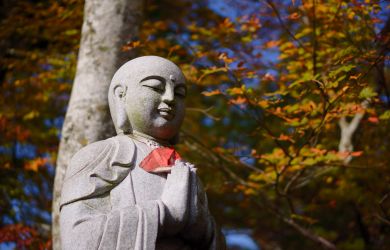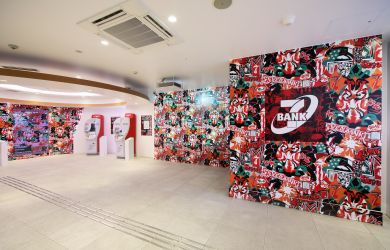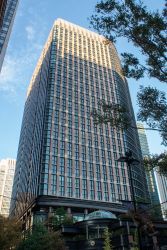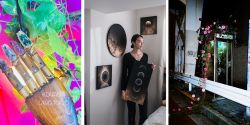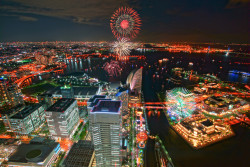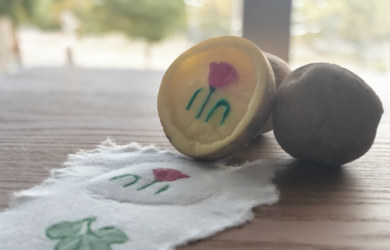
August 17, 2006
The lawless roads of Samoa
Extreme bus driving as a way of life in the South Pacific
By Metropolis
Originally published on metropolis.co.jp on August 2006

Photos by Simon Rowe
It’s 7:30am, but already the air is as hot as the inside of an umu earthen oven down on Beach Street.
A dozen big-bosomed ladies carrying colored parasols drift between the shade of the banyan trees lining Apia’s main thoroughfare, while a policeman, wrapped in his traditional lavalava skirt uniform, takes time out from directing traffic to wipe the sweat from under his egg-shaped helmet.
Samoa might be short on surface area and public telephones, but when it comes to local color, its streets runneth over. From its cosmic pink and yellow public buses to the blinding Hawaiian shirts worn by Apia’s taxi drivers, the sights of the nation’s capital are like Carnavale—South Seas-style. On this tiny Pacific island nation of 160,000 people, you also quickly realize that although wild fashion statements are mode de jour, life itself moves to a rhythm even more subdued than its sun-dazed neighbors, Fiji and Tonga.
At 9am, I find myself on a bus bound for Lalomanu, a tiny village nestled on the rain-soaked south coast of Upolu, Samoa’s most populated island. The old man seated next to me nurses a box of frozen chicken giblets while his sack of salt and two hairy, torpedo-sized taro roots lie wedged between us.
Traveling the blistering highways of Upolu is all about cheating logistics. As any savvy bus rider who hails from a far-flung coastal village or a highland hamlet knows, there’s no such thing as “baggage allowance,” hence the tendency for Samoans to carry aboard every commodity a small Pacific Island nation can possibly produce.
During my travels, I lost count of the times my seat was replaced by a crate of coconuts, a bunch of bananas or a sweating sack of taro leaves. Now and again, it was a live pig, bundled into a pandanus basket, bound for some funeral or wedding feast upcountry, which nuzzled the back of my legs.

To the chagrin of most palangis (foreigners), comprehending Samoa’s public bus system is tricky at best: there’s no official timetable and no ticketing system, and its barefoot drivers go too fast and smoke too much. But what the buses lack in comfort, they make up for in flamboyance and friendliness. With their gaudy paint jobs and names like Peacemaker, Roadmaster, Jungle Boy and Queen Poto daubed in bright colors across the side panels, Samoa’s buses have become a national icon.
Meanwhile, the bus to Lalomanu fills slowly. Old men wearing blinding red and blue Hawaiian shirts hobble in with canes and strange-smelling packages. At 10am, in a pall of hot greasy fumes, we finally depart Apia. Or so I reckon. On the outskirts of town, our barefoot driver swerves into a service station, and all the passengers who have just spent two hours embarking, now disembark in one wild surge to buy up every bag of banana chips, peanuts, sticky cakes and bottle of Coca-Cola the poor Chinese shop owner can toss over the counter.
Hopelessly overloaded and with the chassis groaning to the point of popping its rivets, we speed out onto the coastal highway. Through the window, I glimpse the black volcanic sand beaches of Letogo and Luatuanu’u villages, which form dark brooding lines between the forested mountains and turquoise waters of the inner reef. Great white rollers thunder across the outer reef, just out of reach of two tiny paopao—traditional one-man canoes—which drift lazily across the lagoon.
Apia’s bus drivers are a shrewd bunch. Most know their vehicle’s limits, and most are aware that once they leave the capital, they also leave behind the police department’s five Harley Davidson patrol motorcycles. It’s common knowledge that they intentionally break speed limits in order to be the first to pick up passengers.

“Running a bus is big business,” said one driver. “Without a full bus, we can’t survive.” Competition, thus, remains fierce. There was a time when the soulful tunes of Bob Marley and Marvin Gaye advertised buses long before their arrival in the villages. However, only weeks before I arrived in Apia, a law was passed prohibiting the installation of “musical devices for the purpose of entertainment” in buses. Surprisingly, it listed amplifiers, equalizers and “heavy duty” speakers—items one might normally associate with an industrial-strength reggae party in downtown Montego Bay.
At the village of Solosolo, 35km from Apia, an old man wearing a baseball cap ingeniously woven from dried coconut leaves boards the bus, and I offer him my seat. In appreciation he allows me to sit on his lap. This is not unusual in Samoa, where a fully loaded bus is not necessarily a “full” bus. When there are no more seats, passengers sit on each other. The old-timer introduces himself as Tausisi, then proceeds to light up a Samoan-sized cigarette, almost igniting his hat in the process. Anxious moments follow as I wait for his handicraft to burst into a fireball.
Higher into the hills we climb, crossing Lemafa Pass, the halfway mark to Lalomanu, until the air becomes cool and a light shower passes overhead, dampening the highway. It’s not long before I feel a strange prickly sensation against my back. Mr. Baseball Cap, who I’d noticed was in bad need of a shave, has fallen asleep on me, and his four-day growth is now rasping through my T-shirt.
My itchy predicament was an obvious joke to my fellow passengers, since it was not every day they were witness to a tall, big-nosed palangi riding across Samoa on the lap of a chain-smoking old-timer with cactus whiskers. I, too, managed a wry smile, even though it later meant having to rub a small tub of antihistamine cream over a spotty pink rash.
Samoa is located roughly 2,900km northeast of New Zealand and 4,400km east of Australia. Upolu and Savaii are the main islands, but there are eight smaller ones also worth investigating for their unique village culture. Apia and the Faleolo International Airport are located on the island of Upolu. Air Pacific flies from Narita to the city of Nadi on Fiji on Saturdays and Mondays; there are daily flights to Samoa from Nadi. Check out www.airpacific.com for price specials. No visa is required for stays of less than 60 days, though the burly immigration officers might ask to see a return ticket. Samoa’s dry season is May to October and the wet season is November to April, but the year-round temperatures of 20-30 degrees mean any time of the year is T-shirt-and-shorts weather. Samoa remains a budget traveler’s gem. Expect to live comfortably on 150 Samoan tala, or around ¥6,000 per day. Mid-range to luxury resort rooms are plentiful, but you shouldn’t leave Samoa without spending a night in a fale—the traditional thatched-roof beach hut—with the sea lapping at your doorstep; rates are from ST20-100 (¥850-¥4,000 yen) pp/pn, usually with meals. Check www.visitsamoa.ws for accommodation listings.
[geo_mashup_map]

